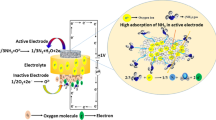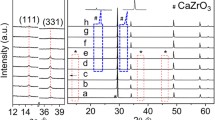Abstract
Mixed-potential type ammonia sensors based on yttria-stabilized zirconia are promising devices in NOx reducing system for high-temperature exhaust. However, selectivity is a critical issue that should be urgently addressed. Herein, a novel bilayer Cr2O3|In2O3 sensing electrode (SE) was designed to improve the selectivity of the ammonia sensor, in which an additional Cr2O3 layer was deposited on In2O3 SE. The selectivity was examined in NH3, CO, NO and NO2. Finally, the sensor with the bilayer Cr2O3|In2O3 SE exhibits an improvement of NH3 selectivity at 600 °C, which is attributed to the Cr2O3 layer catalysing the removal of CO and NOx before the gases reach the triple-phase boundaries (TPBs). Furthermore, the mixed-potential model of the NH3 sensor with the bilayer SE was identified using the polarization curves obtained in different concentrations of NH3. Additionally, the proposed sensor displayed a good repeatability and resistances to CO2 and H2O. This innovative bilayer Cr2O3|In2O3 SE is expected to be applied in high-temperature NH3 detection.












Similar content being viewed by others
Abbreviations
- NOx :
-
Nitrogen oxides
- RE:
-
Reference electrode
- SCR:
-
Selective catalytic reduction
- SE:
-
Sensing electrode
- SEM:
-
Scanning electron microscopy
- TPB:
-
Triple-phase boundary
- YSZ:
-
Yttria-stabilized zirconia
References
Lu Q, Huang L, Li W, Wang T, Yu H, Hao X, Liang X, Liu F, Sun P, Lu G (2021) Mixed-potential ammonia sensor using Ag decorated FeVO4 sensing electrode for automobile in-situ exhaust environment monitoring. Sens Actuat B Chem 348. https://doi.org/10.1016/j.snb.2021.130697
Zou J, Zheng Y, Li J, Zhan Z, Jian J (2015) Potentiometric NO2 sensors based on thin stabilized zirconia electrolytes and asymmetric (La0.8Sr0.2)0.95MnO3 electrodes. Sensors 15:17558–17571. https://doi.org/10.3390/s150717558
Sekhar PK, Brosha EL, Mukundan R, Li WX, Nelson MA, Palanisamy P, Garzon FH (2010) Application of commercial automotive sensor manufacturing methods for NOx/NH3 mixed potential sensors for on-board emissions control. Sens Actuators B Chem 144:112–119. https://doi.org/10.1016/j.snb.2009.10.045
Shah AN, Ge Y, Tan J, Liu Z, He C, Zeng T (2012) Characterization of polycyclic aromatic hydrocarbon emissions from diesel engine retrofitted with selective catalytic reduction and continuously regenerating trap. J Environ Sci 24:1449–1456. https://doi.org/10.1016/s1001-0742(11)60974-1
Bhardwaj A, Kim IH, Mathur L, Park JY, Song SJ (2021) Ultrahigh-sensitive mixed-potential ammonia sensor using dual-functional NiWO4 electrocatalyst for exhaust environment monitoring. J Hazard Mater 403:123797. https://doi.org/10.1016/j.jhazmat.2020.123797
Wang Z, Shan L, Zhou Y, Yuan T, Zhang S, **e G, Gao W, ** Q, Jian J, Zou J (2022) Amperometric ammonia sensors for low detection limit with BaZr(1-x)YxO3-δ proton electrolytes. J Electroana Chem 915:116362. https://doi.org/10.1016/j.jelechem.2022.116362
Tsui L-K, Benavidez A, Palanisamy P, Evans L, Garzon F (2018) Automatic signal decoding and sensor stability of a 3-electrode mixed-potential sensor for NOx/NH3 quantification. Electrochim Acta 283:141–148. https://doi.org/10.1016/j.electacta.2018.06.133
Schönauer D, Nieder T, Wiesner K, Fleischer M, Moos R (2011) Investigation of the electrode effects in mixed potential type ammonia exhaust gas sensors. Solid State Ion 192:38–41. https://doi.org/10.1016/j.ssi.2010.03.028
Yuan Y, Wang B, Wang C, Li X, Huang J, Zhang H, **a F, **ao J (2017) Effects of CoFe2O4 electrode microstructure on the sensing properties for mixed potential NH3 sensor. Sens Actuat B Chem 239:462–466. https://doi.org/10.1016/j.snb.2016.07.171
Prasad AK, Kubinski DJ, Gouma PI (2003) Comparison of sol–gel and ion beam deposited MoO3 thin film gas sensors for selective ammonia detection. Sens Actuat B Chem 93:25–30. https://doi.org/10.1016/s0925-4005(03)00336-8
Guo P, Pan H (2006) Selectivity of Ti-doped In2O3 ceramics as an ammonia sensor. Sens Actuat B Chem 114:762–767. https://doi.org/10.1016/j.snb.2005.07.040
Shimizu K, Chinzei I, Nishiyama H, Kakimoto S, Sugaya S, Matsutani W, Satsuma A (2009) Doped-vanadium oxides as sensing materials for high temperature operative selective ammonia gas sensors. Sens Actuat B Chem 141:410–416. https://doi.org/10.1016/j.snb.2009.06.048
Dhivya P, Prasad AK, Sridharan M (2014) Nanostructured TiO2 films: enhanced NH3 detection at room temperature. Ceram Int 40:409–415. https://doi.org/10.1016/j.ceramint.2013.06.016
Wu Q, Zheng Y, Jian J, Wang J (2016) Gas sensing performance of ion-exchanged Y zeolites as an impedimetric ammonia sensor. Ionics 23:751–758. https://doi.org/10.1007/s11581-016-1849-0
Auckenthaler TS, Onder CH, Geering HP, Frauhammer J (2004) Modeling of a three-way catalytic converter with respect to fast transients of λ-sensor relevant exhaust gas components. Ind Eng Chem Res 43:4780–4788. https://doi.org/10.1021/ie034242u
Miura N, Sato T, Anggraini SA, Ikeda H, Zhuiykov S (2014) A review of mixed-potential type zirconia-based gas sensors. Ionics 20:901–925. https://doi.org/10.1007/s11581-014-1140-1
Sato T, Ikeda H, Miura N (2014) Mixed-potential type zirconia-based NH3 sensor using SnO2-disk sensing-electrode attached with sputtered Au. ECS Electrochem Lett 3:B13–B15. https://doi.org/10.1149/2.004406eel
Meng W, Dai L, Zhu J, Li Y, Meng W, Zhou H, Wang L (2016) A novel mixed potential NH3 sensor based on TiO2@WO3 core-shell composite sensing electrode. Electrochim Acta 193:302–310. https://doi.org/10.1016/j.electacta.2016.02.028
Abkenar GN, Rieu M, Breuil P, Viricelle JP (2021) Development of a selective ammonia YSZ-based sensor and modeling of its response. Sens Actuat B Chem 338. https://doi.org/10.1016/j.snb.2021.129833
Dai L, Yang G, Zhou H, He Z, Li Y, Wang L (2016) Mixed potential NH3 sensor based on Mg-doped lanthanum silicate oxyapatite. Sens Actuat B Chem 224:356–363. https://doi.org/10.1016/j.snb.2015.10.071
Wang C, Yang B, Xu J, **a F, **ao J (2019) Effects of CeVO4 electrode morphology and oxygen content on ammonia sensing properties for potentiometric sensor. Sens Actuat B Chem 299. https://doi.org/10.1016/j.snb.2019.126863
Wang C, Li X, **a F, Zhang H, **ao J (2016) Effect of V2O5-content on electrode catalytic layer morphology and mixed potential ammonia sensor performance. Sens Actuat B Chem 223:658–663. https://doi.org/10.1016/j.snb.2015.09.145
Wama R, Plashnitsa VV, Elumalai P, Utiyama M, Miura N (2010) Impedancemetric zirconia-based sensor attached with laminated-oxide sensing-electrode aiming at highly sensitive and selective detection of propene in atmospheric air. Solid State Ion 181:359–363. https://doi.org/10.1016/j.ssi.2010.01.010
Elumalai P, Plashnitsa VV, Ueda T, Miura N (2008) Sensing characteristics of mixed-potential-type zirconia-based sensor using laminated-oxide sensing electrode. Electrochem Commun 10:745–748. https://doi.org/10.1016/j.elecom.2008.02.028
Schönauer-Kamin D, Fleischer M, Moos R (2014) Influence of the V2O5 content of the catalyst layer of a non-Nernstian NH3 sensor. Solid State Ion 262:270–273. https://doi.org/10.1016/j.ssi.2013.08.035
Yamaguchi M, Anggraini SA, Fujio Y, Sato T, Breedon M, Miura N (2013) Stabilized zirconia-based sensor utilizing SnO2-based sensing electrode with an integrated Cr2O3 catalyst layer for sensitive and selective detection of hydrogen. Int J Hydrog Energy 38:305–312. https://doi.org/10.1016/j.ijhydene.2012.10.049
Lee I, Jung B, Park J, Lee C, Hwang J, Park CO (2013) Mixed potential NH3 sensor with LaCoO3 reference electrode. Sens Actuat B Chem 176:966–970. https://doi.org/10.1016/j.snb.2012.09.009
Dai L, Liu Y, Meng W, Yang G, Zhou H, He Z, Li Y, Wang L (2016) Ammonia sensing characteristics of La10Si5MgO26-based sensors using In2O3 sensing electrode with different morphologies and CuO reference electrode. Sens Actuat B Chem 228:716–724. https://doi.org/10.1016/j.snb.2016.01.106
** H, Huang Y, Jian J (2015) Sensing mechanism of the zirconia-based highly selective NO sensor by using a plate-like Cr2O3 sensing electrode. Sens Actuat B Chem 219:112–118. https://doi.org/10.1016/j.snb.2015.04.123
Elumalai P, Plashnitsa VV, Ueda T, Hasei M, Miura N (2007) Dependence of NO2 sensitivity on thickness of oxide-sensing electrodes for mixed-potential-type sensor using stabilized zirconia. Ionics 13:387–393. https://doi.org/10.1007/s11581-006-0063-x
Elumalai P, Hasei M, Miura N (2006) Influence of thickness of Cr2O3 sensing-electrode on sensing characteristics of mixed-potential-type NO2 sensor based on stabilized zirconia. Electrochemistry 74:197–201. https://doi.org/10.5796/electrochemistry.74.197
Li F, ** H, Wang J, Zou J, Jian J (2017) Selective sensing of gas mixture via a temperature modulation approach: new strategy for potentiometric gas sensor obtaining satisfactory discriminating features. Sensors 17. https://doi.org/10.3390/s17030573
** H, Breedon M, Plashnitsa VV, Miura N (2012) Working mechanism of novel Mn-based reference electrode for solid-state electrochemical gas sensors. J Electrochem Soc 159:B801–B810. https://doi.org/10.1149/2.035210jes
Sato T, Breedon M, Miura N (2012) Improvement of toluene selectivity via the application of an ethanol oxidizing catalytic cell upstream of a YSZ-based sensor for air monitoring applications. Sensors 12:4706–4714. https://doi.org/10.3390/s120404706
Tsitron J, Kreller CR, Sekhar PK, Mukundan R, Garzon FH, Brosha EL, Morozova AV (2014) Bayesian decoding of the ammonia response of a zirconia-based mixed-potential sensor in the presence of hydrocarbon interference. Sens Actuat B Chem 192:283–293. https://doi.org/10.1016/j.snb.2013.10.115
Zou J, Liu X, ** H, Zhan Z, Jian J (2015) NO2 sensing properties of electrode-supported sensor by tape casting and co-firing method. Ionics 21:2655–2662. https://doi.org/10.1007/s11581-015-1430-2
Yang B, Wang C, **ao R, Yu HY, Huang CQ, Wang JX, Xu JL, Liu HM, **a F, **ao JZ (2019) High NH3 selectivity of NiFe2O4 sensing electrode for potentiometric sensor at elevated temperature. Anal Chim Acta 1089:165–173. https://doi.org/10.1016/j.aca.2019.09.006
Kalyakin A, Volkov A, Vylkov A, Gorbova E, Medvedev D, Demin A, Tsiakaras P (2018) An electrochemical method for the determination of concentration and diffusion coefficient of ammonia-nitrogen gas mixtures. J Electroana Chem 808:133–136. https://doi.org/10.1016/j.jelechem.2017.12.001
Li X, Wang C, Huang J, Yuan Y, Wang B, Zhang H, **a F, **ao J (2016) The effects of Cu-content on Mg2CuxFe1O3.5+x electrodes for YSZ-based mixed-potential type NH3 sensors. Ceram Int 42:9363–9370. https://doi.org/10.1016/j.ceramint.2016.02.118
Wang L, Meng W, He Z, Meng W, Li Y, Dai L (2018) Enhanced selective performance of mixed potential ammonia gas sensor by Au nanoparticles decorated CeVO4 sensing electrode. Sens Actuat B Chem 272:219–228. https://doi.org/10.1016/j.snb.2018.05.156
Liu F, Li S, He J, Wang J, You R, Yang Z, Zhao L, Sun P, Yan X, Liang X, Chuai X, Lu G (2019) Highly selective and stable mixed-potential type gas sensor based on stabilized zirconia and Cd2V2O7 sensing electrode for NH3 detection. Sens Actuat B Chem 279:213–222. https://doi.org/10.1016/j.snb.2018.09.024
Park J-Y, Azad A-M, Song S-J, Wachsman ED (2010) Titania-based miniature potentiometric carbon monoxide gas sensors with high sensitivity. J Am Ceram Soc 93:742–749. https://doi.org/10.1111/j.1551-2916.2009.03446.x
Macam ER, Blackburn BM, Wachsman ED (2011) The effect of La2CuO4 sensing electrode thickness on a potentiometric NOx sensor response. Sens Actuat B Chem 157:353–360. https://doi.org/10.1016/j.snb.2011.05.014
Elumalai P, Zosel J, Guth U, Miura N (2009) NO2 sensing properties of YSZ-based sensor using NiO and Cr-doped NiO sensing electrodes at high temperature. Ionics 15:405–411. https://doi.org/10.1007/s11581-009-0354-0
Elumalai P, Plashnitsa V, Fujio Y, Miura N (2008) Stabilized zirconia-based sensor attached with NiO/Au sensing electrode aiming for highly selective detection of ammonia in automobile exhausts. Electrochem Solid-State Lett 11:J79–J81. https://doi.org/10.1149/1.2971171
Lu Q, Huang L, Hao X, Li W, Wang B, Wang T, Liang X, Liu F, Wang C, Lu G (2021) Mixed potential type NH3 sensor based on YSZ solid electrolyte and metal oxides (NiO, SnO2, WO3) modified FeVO4 sensing electrodes. Sens Actuat B Chem 343. https://doi.org/10.1016/j.snb.2021.130043
Meng W, Wang L, Li Y, Zhou H, He Z, Meng W, Dai L (2019) Mixed-potential type NH3 sensor based on CoWO4-PdO sensing electrode prepared by self-demixing. Electrochim Acta 321. https://doi.org/10.1016/j.electacta.2019.134668
Funding
This work was financially supported by the National Natural Science Foundation of China (61971251), and China Postdoctoral Science Foundation (grant no. 2019M663474), Natural Science Foundation of Zhejiang (grant no. LGG22F010017, LY18F010009), Natural Science Foundation of Ningbo (grant no. 2018A610002) and Scientific Research Foundation of Education Department of Zhejiang Province (grant no. Y201942817).
Author information
Authors and Affiliations
Corresponding authors
Additional information
Publisher's Note
Springer Nature remains neutral with regard to jurisdictional claims in published maps and institutional affiliations.
Supplementary Information
Below is the link to the electronic supplementary material.
Rights and permissions
Springer Nature or its licensor (e.g. a society or other partner) holds exclusive rights to this article under a publishing agreement with the author(s) or other rightsholder(s); author self-archiving of the accepted manuscript version of this article is solely governed by the terms of such publishing agreement and applicable law.
About this article
Cite this article
Zhang, D., Zou, J., Li, F. et al. Improvement on mixed-potential type ammonia sensor by a Cr2O3 gas-phase catalyst layer. J Solid State Electrochem 27, 1011–1020 (2023). https://doi.org/10.1007/s10008-023-05376-2
Received:
Revised:
Accepted:
Published:
Issue Date:
DOI: https://doi.org/10.1007/s10008-023-05376-2




